If these walls could talk…
The History of Tribeca Buildings database—compiled from Tom Miller’s posts at Daytonian in Manhattan—has six more entries on the properties below. (Click the address to read the full text.) If you enjoy these, and you will, then you should definitely check out his website, which also has write-ups about buildings all over the island. And don’t miss his book, Seeking New York: The Stories Behind the Historic Architecture of Manhattan—One Building at a Time.
··················
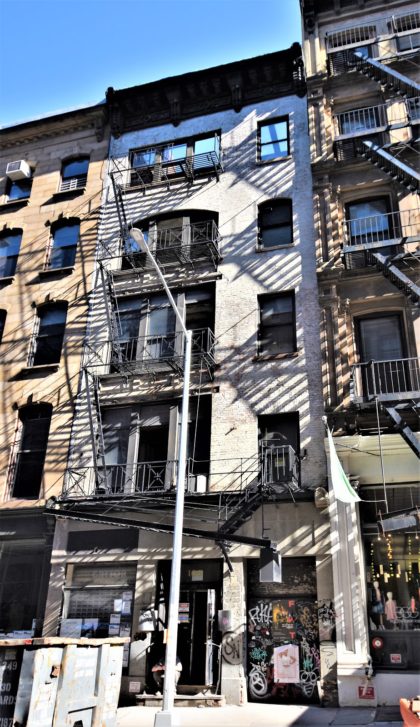 106 FRANKLIN
106 FRANKLIN
By the 1830’s the block of Franklin Street between Church Street and West Broadway was lined with handsome Federal-style residences. No. 106 reflected the fashionable nature of the neighborhood. Faced in brick it rose three full stories to a pitched roof with prominent dormers. At 25-feet wide, it was on par with the homes of the city’s most prominent citizens. The upscale tone of the home was also evidenced by its resident, the Episcopal Bishop of New York, Benjamin Treadwell Onderdonk. […] When a candidate for the ministry, Arthur Carey, was interviewed by Rev. Dr. Hugh Smith of St. Peter’s Church, he expressed views sympathetic to Roman Catholicism. It was a serious matter in 1843—Roman Catholics were called “Papists” (and worse). Rev. Smith called for an inquiry, but Onderdonk deemed Carey suitable for ordination, and a backlash erupted. The Bishop, too, was accused of pro-Catholic sentiments. During the uproar, the Bishop of Virginia, William Meade, produced a number of affidavits from women who alleged Onderdonk had “engaged in improper touching” and had made inappropriate advances. Onderdonk fought the charges, proposing that the women were paid to make the charges so his enemies could get rid of him. But a resulting trial before the House of Bishops ended in Onderdonk’s suspension. While he retained his position—at least in title—he was unable to celebrate mass or any other of his priestly duties.
··················
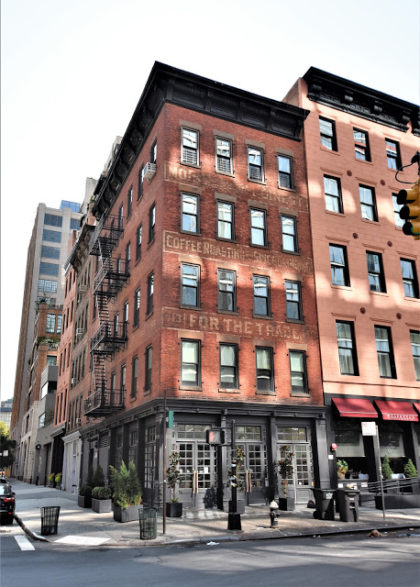 413 GREENWICH
413 GREENWICH
In 1901, William J. Morrison and Walter B. Boinest formed the Morrison & Boinest Co. The pair had been employed for years by Frederick Akers, the proprietor of New York’s oldest and best known coffee roasting establishment. Following Akers’ death that year, they formed the new company to carry on the same type of business. Morrison & Boinest Co. roasted imported coffee beans, and ground spices. Interestingly, it did not involve itself in merchandising the products, providing the service instead for other firms. A 1904 advertisement noted boldly, “We Do Not Buy,” and “We Do Not Sell.” The ad stressed, “We Do Not Compete With Our Customers,” adding “We Roast Coffee for the Trade Only.” As was customary in the early 20th century, the building’s facade became a billboard of sorts. Signage was painted across the brickwork that announced, “Morrison & Boinest,” “Coffee Roasting and Spice Grinding,” and “For The Trade.” Ghosts of the signage survives.
··················
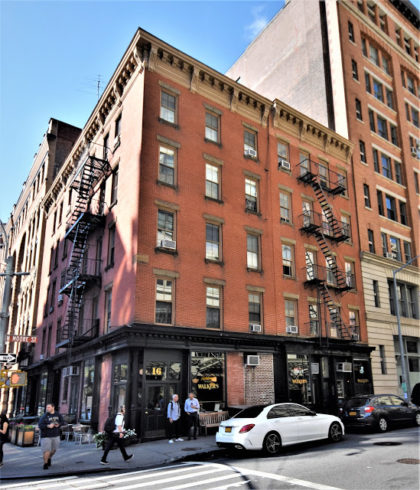 16 N. MOORE
16 N. MOORE
In January, 1973, The New York Times noted, “The building, which has a bar and grill on the ground floor, is occupied mainly by single men.” Those men were, according to police, mostly homosexuals. Donald MacNiven was 40 years old and his next-door neighbor, John Beardsley, was 53. Both had lived in their fifth-floor apartments here for about a decade. When firefighters responded to a fire in MacNiven’s two-room apartment on January 8, 1973, they found both men dead on the living room floor. The fire was described as “suspicious” and both MacNiven and Beardsley had multiple stab wounds. The attacks soon appeared to be just the beginning of a reign of terror. Days later, another gay man, Ronald Cabo, was found stabbed to death in his Thompson Street apartment. And then on January 19, 1973, The Times reported, “The discovery of the bodies of two young men floating in the Hudson River off Greenwich Village added yesterday to the fears of the homosexual community, already stunned by the three recent murders of homosexuals in the area.”
··················
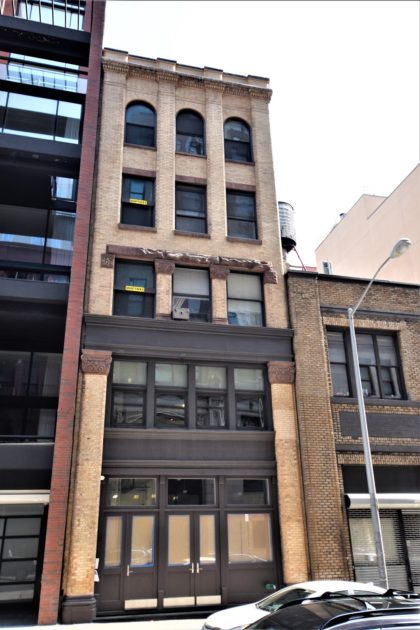 88 WHITE
88 WHITE
By 1914, the automobile had become a noticeable presence on America’s roadways. Automobilists, as owners were called, customized their motorcars with any number of accessories; and all of them could be found at B. E. Mfg. Co., which called No. 88 home. The seeming inexhaustible list of items it manufactured included collapsible buckets (for those unfortunate motor fires); spark plug cases; covers for the entire automobile or parts like the lamps, radiator, hood, and spare tire; and “starting crank holders.” The description of that accessory read “leather strap and holder to prevent starting crank swinging or dropping down.” Also available were “motorists’ leggings,” door protectors (“leather or fabric pads to protect the finish of the door”), cushion back rests, wash aprons, bags or rolls for tools, reflector sockets and a number of other items.
··················
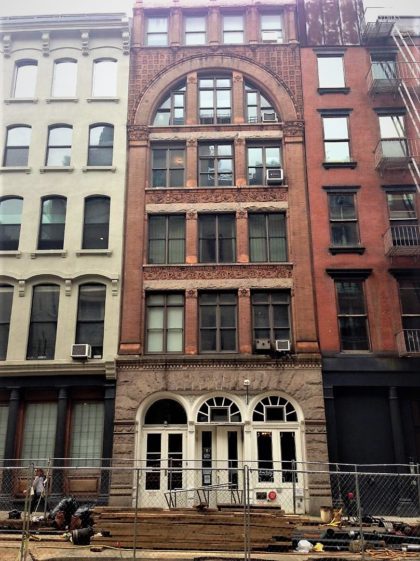 73 WARREN
73 WARREN
Around 1900, the store space was home to Dr. P. Harvey Flynn’s veterinary supply store. Unlike the rawhide bones and doggie sweaters carried by such retailers today, the products sold had more to do with the thousands of horses that populated Manhattan. He, like his landlord had done, came up with a solution to a ubiquitous problem in 1899. Runaway horses were dangerous, killing or injuring numerous people per year. Flynn invented the My Little Giant Controller, a type of bit which he guaranteed to stop and control any skittish horse. While he marketed the gadget as “completely humane,” his description in The New York Times on March 25, 1899, said the horse “will not run; he cannot run; the pain caused by a steady pull is too intense to permit him to fight against it.” Flynn insisted, “I know that I have been saved from accident, possibly from death, while driving spirited horses, by the use of this simple contrivance.” And he urged, “It is an appliance that should be on every harness, used by a woman particularly.”
··················
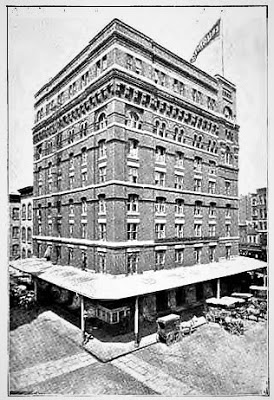 126-128 FRANKLIN
126-128 FRANKLIN
Disaster for the impressive Francis H. Leggett & Co. building came not from fire or explosion, but civic improvement. In 1904, C. C. Hickok had begun a push to extend Seventh Avenue southward. Finally, on June 21, 1913, The Record & Guide reported that the city would begin appropriating property “for the extension of the avenue from Greenwich avenue to Carmine street, for the widening of Varick street from Carmine to Franklin and for the extension of Varick street from Franklin to West Broadway.” Standing in the route of the Varick Street widening was more than half of the Leggett building. With much of its structure now gone, Leggett & Co. hired the esteemed architect C. P. H. Gilbert to erect a western wall. The firm need not have gone to the top of the architectural heap in selecting its designer; for the resultant patch was a simple, brick wall.
··················













